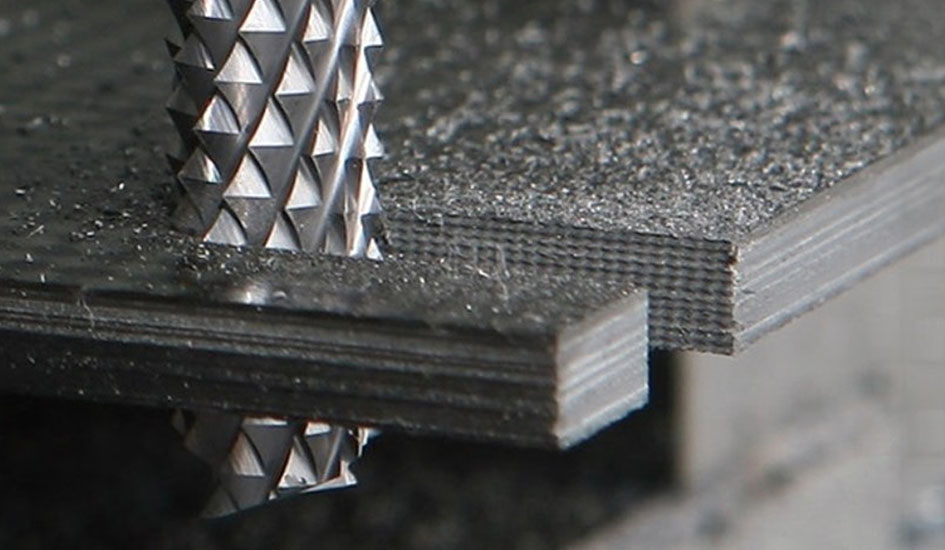Diamond-coated tools have transformed the precision machining of challenging materials by providing unparalleled hardness, durability, and efficiency. As a leader in cutting tools, TaeguTec has made substantial investments in diamond coating technology to create tools that enhance machining performance across various industries, including aerospace, automotive, and defence.
TaeguTec introduced its diamond-coated tools eight years ago, initially focusing on solid carbide drills and end mills. Over time, the company expanded its offerings to include indexable inserts for milling and turning applications. Unlike most cutting tool manufacturers that outsource the diamond coating process, TaeguTec has developed an in-house process. This enables greater process control, which in turn drives quality and innovation. Jin Cheon, TaeguTec’s Round Tool Product Manager, said, “We were one of the first companies to bring diamond coating in-house.” This move gave us a competitive edge because we can fine-tune the process to match our customers’ needs.”
To maximise tool life and performance through reduced tool wear and improved heat resistance, TaeguTec primarily utilises two types of diamond coatings. The Korean manufacturers’ micro-crystalline diamond coating is specifically designed for machining highly abrasive materials, such as graphite and ceramics. This micro-crystalline is selected for its exceptional wear resistance. In contrast, TaeguTec also offers a nano-crystalline diamond coating that is ideal for machining composite materials, such as Carbon Fiber Reinforced Plastic (CFRP) and Glass Fiber Reinforced Plastic (GFRP), as it provides smoother surface finishes and reduces the potential for delamination and uncut fibers during machining.
As one of TaeguTec’s R&D specialists, Mr. Jung, explained, “Micro-crystalline coatings are ideal for high-wear environments, such as those found in graphite machining.” However, a smoother, nano-crystalline coating is preferred when working with composites, as it reduces delamination issues and creates a sharper edge on the tools. It’s all about applying the right technology for the right job.”
To ensure complete process control and provide the company with scope for development, TaeguTec invested in the HF-CVD diamond coating technology from one of the most advanced diamond coating equipment companies. After rigorous testing and due diligence in the marketplace, the technology was chosen for its superior optimisation for cutting tools. We evaluated multiple technologies before selecting our supplier. Their equipment provided the best balance between performance, consistency, and cost-effectiveness. By controlling coating thickness and structure, we can tailor our diamond-coating process and the respective tools to meet diverse machining demands,” said Jung.
One major innovation attained via the HF-CVD diamond coating system is the ability to customise the thickness and grain structure of the diamond coating. This enables TaeguTec to optimise wear resistance and cutting edge sharpness. TaeguTec fine-tunes these parameters to maximise tool life, developing tools from the molecular structural phase. By controlling the coating thickness, we ensure that our tools remain sharp while maintaining their durability. Too thick and the edge dulls; too thin and the tool wears out quickly,” Jung elaborated.
Of course, the coating is only as good as the coating process, adhesion and tool composition. TaeguTec recognises this, and the South Korean industry leader has made crucial advancements in cobalt leaching to improve coating adhesion. Cobalt serves as a binder in tungsten carbide substrates, making it a crucial element in carbide cutting tools. Cobalt can interfere with the diamond adhesion process; therefore, TaeguTec removes surface cobalt through an in-house specialist acid treatment process to enhance the bond between the substrate and the diamond coating. Cobalt can act as a barrier between the carbide and the diamond coating. Our process eliminates that issue and ensures stronger adhesion. Fundamentally, the TaeguTec process removes the surface cobalt to greater depths than alternative methods. This provides the adhesion of our diamond coating is far superior, delivering significantly improved performance and tool life,” Jung explained.
Additionally, application-specific geometry adjustments play a vital role. TaeguTec designs tool geometries tailored to applications specific to the aerospace, automotive, and semiconductor industries, among others. This ensures that the sharpness of cutting edges is maintained while guaranteeing sufficient coating thickness for durability. “We collaborate closely with our customers to develop the right geometries. A tool designed for aluminium might not work well for CFRP, so customisation is key,” said Jin.
TaeguTec’s diamond-coated tools also provide significant cost savings in these high-performance industries. Their extended tool life reduces downtime and the frequency of tool replacement, thereby increasing production efficiency. “A tool that lasts ten times longer means fewer interruptions in the machining process, reducing labour costs and increasing overall productivity,” Jin explained.
Another significant benefit is the superior heat resistance of diamond coatings. Compared to conventional carbide tools, diamond-coated tools maintain their integrity at significantly higher temperatures, making them ideal for high-speed machining applications. Heat buildup is a significant issue in precision machining. We can eliminate most of that issue with diamond-coated tools, allowing for more aggressive cutting speeds without compromising tool performance,” Jin noted.
Industry Solutions
TaeguTec’s diamond-coated tools have been widely adopted in industries requiring precision machining. In aerospace, CFRP components in aircraft wings and structural parts require smooth cutting to avoid fiber delamination. TaeguTec’s nano-crystalline coatings offer superior edge retention and reduced tool wear. As TaeguTec’s Round Tool Product Manager, Jin continues: “Aerospace customers need consistency. If a tool fails mid-process, it can result in thousands of dollars in costs. Our coatings ensure reliability and consistency, instilling confidence in the process.
In the automotive industry, there is a shift from steel to lightweight materials, such as high-silicon-content aluminium alloys. Diamond tools provide the necessary wear resistance and precision. Automotive manufacturers are continually seeking ways to reduce weight while maintaining strength. Diamond coatings help us machine these materials efficiently,” said Jin.
“In the defence industry, applications benefit from the arrival of diamond-coated tools, especially in machining radar components and missile guidance systems, which demand extreme precision. The defence sector requires flawless accuracy and surface finishes. A tiny deviation can mean the difference between success and failure. Our coatings help maintain that precision,” Jin emphasised.
The semiconductor industry also relies on high-precision machining of ceramic substrates. TaeguTec’s diamond tools provide the necessary performance for these critical components. Even the slightest inconsistency can cause significant problems during the machining of semiconductor components. Our tools help maintain the highest standards,” the TaeguTec R&D specialist explained.
To cater to the diverse demands of the marketplace, TaeguTec’s diamond-coated end mills are available in four different types. The RRFE Series eliminates delamination when machining CFRP while minimising vibration and cutting forces via its innovative geometry, making this range perfect for rough machining applications that demand unprecedented productivity levels. This is complemented by the RCFE range, a geometry applied to multi-flute routers. With 6 to 12 flutes and a 15-degree helix angle, the RCFE is part of the renowned DiaMill Series from TaeguTec.
For finishing applications, the RCOM range of diamond-coated end mills, available in diameters ranging from 6 to 12mm, incorporates a left- and right-hand helix, commonly referred to as ‘up-down’ cutters in some sectors. The RCOM eradicates delamination with its unique geometry design. Also from the finish machining stable are the low-helix RDCF-type end mills, which complement the RCOM range and are the first-choice solution for addressing concerns related to splintering and delamination on CFRP parts.
TaeguTec has added the new RCDE multi-flute router to the DiaMill range, enhancing capabilities for drilling and slotting. Excellent for rough to semi-finish machining of carbon fiber components, the RCDE presents a geometry that excels at drilling CFRP and shoulder milling operations. All these DiaMill designations have been developed using TaeguTec’s TTD610 advanced nano diamond coating grade, which enhances machining stability and tool life while delivering excellent wear resistance with hardness exceeding Hv 8000. This gives all five end mills the highest possible thermal conductivity, impact resistance, and stability.
Additionally, TaeguTec’s innovations in indexable diamond-coated inserts are expected to drive further cost savings. The arrival of diamond-coated indexable inserts eliminates the tradition of only coating solid carbide end mills and drills. “Customers will no longer need to replace an entire solid carbide tool. They can swap out an insert, reducing waste and improving efficiency. The potential for cost savings and productivity gains here are significant,” Jin commented.
A sustainable solution
TaeguTec prioritises environmental and worker safety in its diamond coating processes and manufacturing facility. Our company exceeds governmental regulations by ensuring the safe handling of chemicals for cobalt leaching and diamond deposition. Employee training is conducted annually to ensure adherence to safety protocols. We go beyond standard regulations. Safety is a top priority for compliance, as we care about both our employees and the environment.
The company has also invested in sustainable practices, reducing chemical waste and optimising coating processes to minimise environmental impact. “We’re constantly looking for ways to make our processes greener while maintaining the highest quality standards,” Jung explained.
The Future of Diamond Tools
TaeguTec is continuously improving its diamond coating processes. Ongoing research focuses on enhancing coating adhesion and developing multi-layer coatings to increase bonding strength between the substrate and the diamond layer. The company is also expanding its product lines, introducing diamond-coated indexable inserts for milling and turning applications. “Indexable inserts coated with diamond will give customers more flexibility while reducing costs in the long run,” said Jung.
“To elevate production efficiency, we are fine-tuning the coating parameters to improve cost-effectiveness and scalability. We’re always looking for ways to optimise our processes and the performance of our tools across the entire spectrum of workpiece materials. If we can make a tool last even 20% longer, that’s a huge win for our customers. We will refine and test our processes, from the acids used in acid baths to leach cobalt and the duration spent in the baths to the coating and bonding processes. With in-house R&D, manufacturing and testing, our scientists and engineers will continue to evolve our processes to create the optimal tool for every process and applicable material type,” Jung noted.
Despite entering the market with diamond-coated tooling just eight years ago, TaeguTec’s extensive investment in in-house diamond coating technology and relentless innovation and development culture has positioned it as a leader in precision cutting tools. By leveraging advanced coatings, optimising geometries, refining its adhesion processes, and then combining this with its decades of expertise in R&D, the company continues to push the boundaries of tool performance.
As industries evolve, TaeguTec’s commitment to innovation ensures that its diamond-coated tools will remain at the forefront of machining excellence. “We’re just getting started. ” There’s so much potential for diamond coatings, and we’re excited to see where the technology takes us,” Jin concluded.





